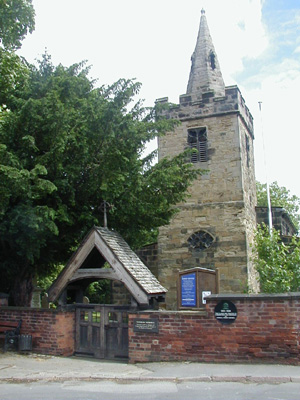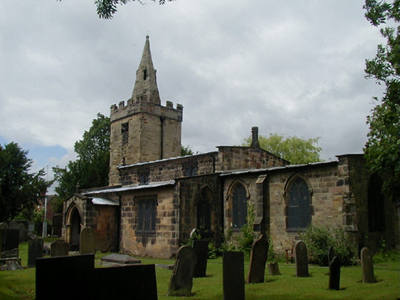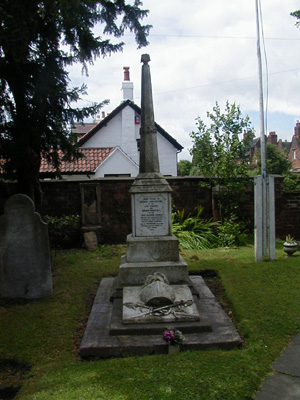St Catherine's Church, Cossall
The Church at Cossall is dedicated to Saint Catherine, a native of Alexandria, she was both beautiful and learned. The Emporer Maximain was very much attracted to her, but because she refused his attentions he ordered her to be tortured. She survived the torture but was then beheaded and buried on Mount Sinain.
The church is quite small and stands at a tight bend in the hilltop village. The entrance to the churchyard is through a traditional lychgate built as a memorial in 1928.
The original nave and chancel were built in the 13th Century with arcades built later. The south side in the 14th Century but the north side appears to be part of the 1842 alterations. There were alterations in 1718, but there were major changes in 1842-43. It is recorded that the cost was borne by the vicar the Rev Francis Hewgill. Cossall was a parochial chapelry annexed to Wollaton and Rev Hewgill was Rector of Wollaton. The church was annexed to Wollaton until 1947.
Under an arched recess in the sanctuary there is a marble tomb of the Willoughbys of Cossall, remembered for the Almshouses (near the church) founded by George Willoughby in 1685. These were originally for “4 single poor men over 60 years of age and 4 single poor women over 55 years of age”. There was an endowment of a farm at Roston and local land rents to enable the inmates to be paid £10 per year and clothe them with a new grey cloth gown worth 3d per yard every 2 years, also to supply them with 5 shillings worth of coal yearly. Lord Middleton, who until 1926 resided at Wollaton Hall, is a trustee of the Cossall Almshouses.
There is a fine oak reredos, carved by village workers.


The Willoughby vault was last opened for interment of Miss Willoughby from Nottingham in 1780. The workmen were surprised by a luminous appearance at the far end of the vault. After examination the light turned out to be a human skull covered with a light green phosphorescent mould.
Cossall is also remembered for connections with D H Lawrence, who was born at Eastwood. Next to the church is Church Cottage which was the former home of the Burrows family. Lawrence was engaged to pupil teacher, Louie Burrows in 1910. Louie was the daughter of Alfred and Louise Burrows. Cossall features in in the Lawrence novel “The Rainbow” where it is called “Cossethay”. The Television version of the book was filmed in Cossall.
The tower is 13th Century and contains two bells in an old wooden frame, the larger of the bells is 22½” in diameter and bears the inscription T.TVRY. P SYSON. C.W. 1733. The smaller is 22″ in diameter and has no inscription.
There is a 15th Century Font.
In the south window is a small stained glass window depicting St Catherine.
Just inside the churchyard adjacent to the lychgate there is an obelisk, the ‘Waterloo Memorial’, erected to the memory of John Shaw and Richard Waplington of the Life Guards and Thomas Wheatley of the Light Dragoon Guards who fought at Waterloo.
- John Shaw – a place of honour in history for unparalleled bravery known throughout the land. On 15th October 1807 when he was 18 years old he enlisted in the Life Guard. He received many wounds at the Battle of Waterloo and died the next day. He was buried at La Haye Sainte.
- Richard Waplington – known with Shaw as the ‘Cossall Giants’. He was last seen holding a French Eagle surrounded by cuirasses (mounted soldiers wearing armour) and was not seen again.
- Thomas Wheatley – younger than the other two, a stocking weaver, fought with great distinction at Genappes and Waterloo. He returned home and became a blacksmith at Babbington Colliery. In 1832 he distinguished himself in defence of Wollaton Hall against the mob who destroyed Nottingham Castle and Beeston Mills. He died in Cossall Almshouses and is buried in Cossall churchyard.
Extracts from the Domesday Book and Truam’s ‘History of Ilkeston’:
- ‘William de Cossall was Baron of the Exchequer under king Edward III. In Cotshale (Cossall) Richard Peveril hld 6 oxgangs of land (land for 6 oxen)’
- In 1569 Roger Hart of Cotshale took 9d to court at Nottingham Castle.
- In 1284 Roger de Morteyne had leave to catch rabbits in Cotshale and in 1337 the same right was given to Richard de Willoughby, who had married Sir Roger Morteyne’s daughter and thus acquired land at Cotshale.
- In 1568 the Manor of Cossall, alias Cossall Marsh, late belonging to Newstead Abbey, was granted to P. Bowes and T. Major, but was at the time in the occupation of Francis Willoughby.

Click to explore the list of known Cossall Vicars
Date from — Priest
1879 — Revd D C Bufrell
1884 — Revd R Hitchcock
1891 — Revd H S Arkwright
1894 — Revd H Milnes Walker (from a carriage clock with an inscription 'presented on the occasion of his marriage June 1894 by the parishioners of Cossall')
1897 — Revd G H Fooks
1898 — Revd W J F Elar
1903 — Revd J C Holden
1909 — Revd E J Dallen
1923 — Revd W B Lawrence
1929 — Revd T Billingham
1937 — Revd Norton Hull
1939 — Revd E J W Ferguson
1940 — Revd P J Powlesland
29.07.1947 — Revd Herbert Leslie Hobson
20.03.1959 — Revd Richard Henry Smart
02.10.1963 — Revd Wilfred Lawson Archer
1966 — Revd Miles
02.09.1970 — Revd Walter Davies
08.03.1974 — Revd Leslie Cowley
29.09.1977 — Revd David Alan Roberts
12.11.1982 — Revd D C Bignall
08.12.1986 — Revd J A Parfitt
14.07.1992 — Revd Duncan McMann
18.04.2000 — Revd Graham R Booth (Rector of Awsworth, Cossall and Trowell)
01.07.2001 — Revd Joan Whysall (Curate)
10.05.2006 — Revd Andy Lord
Thanks to Michael Fitch for the information on Rev. H Milnes Walker.